| Pages:
1
2
3
..
12 |
crazyboy
Hazard to Others
  
Posts: 436
Registered: 31-1-2008
Member Is Offline
Mood: Marginally insane
|
|
do-it-yourself nuclear magnetic resonance spectroscopy
In his thread "Synthesis of Arecoline - 3 Steps from Nicotinic Acid" Arrhenius mentioned that he had an NMR at his house. Now whether I misinterpreted
his statement or not it got me thinking about the viability of an NMR at home. Now of course the standard NMR is way out of an amateurs reach. Aside
from the 500k price tag and sheer size of the machine, it requires that it be constantly filled with an inner jacket of liquid helium and an outer
jacket of liquid nitrogen. The cost of the cryogenic liquids alone would be astronomical.
However there is a device known as an "earth's field NMR" I won't pretend I fully understand how it works so here is the Wikipedia entry: http://en.wikipedia.org/wiki/Earth%27s_field_NMR Sufficed to say it uses frequencies around 2 kHz (give or take depending on geographic location)
and requires no cryogenic liquids.
These earth's field NMRs or EFNMRs as they are called are sold to educators and to small universities. I saw one quoted at about $3400, while this is
quite expensive it is nowhere near as much as a cryogenic NMR. The website that supply these devices list experiments that can be done with them; I
don't know how useful these are as analytical tools maybe someone else could shed some light?
Information on Nuclear Magnetic Resonance:
http://en.wikipedia.org/wiki/Nuclear_magnetic_resonance
http://en.wikipedia.org/wiki/NMR_spectroscopy
http://www2.chemistry.msu.edu/faculty/reusch/VirtTxtJml/Spec...
Information and vendors for Earth's Field Nuclear Magnetic Resonance:
http://en.wikipedia.org/wiki/Earth%27s_field_NMR
http://www.earthsfield-nmr.com/
http://www.magritek.com/terranova.html
http://www.teachspin.com/instruments/earths_field_NMR/index....
http://www.exstrom.com/magnum_old.html
The last link I posted is of a company called extrom, they no longer sell a EFNMR however they have a book called "Signals from the Subatomic World:
How to Build a Proton Precession Magnetometer" Which apparently has detailed instructions on building a proton precession magnetometer with computer
integrated data sampling and analysis. Below is the link with information on the book.
http://www.exstrom.com/magnum.html
[Edited on 8-30-2010 by Polverone]
|
|
|
densest
Hazard to Others
  
Posts: 359
Registered: 1-10-2005
Location: in the lehr
Member Is Offline
Mood: slowly warming to strain point
|
|
Looks like an interesting DIY project. Is the software available? Does it run on Linux? Winding the coils is tedious but doable.
|
|
|
not_important
International Hazard
    
Posts: 3873
Registered: 21-7-2006
Member Is Offline
Mood: No Mood
|
|
The native field NMR systems must work with a __very__ low signal level and fairly high background noise, both manmade and natural. They also are
fairly low resolution, making their use for general structural determination difficult. Those mean that long acquisition times are often needed.
Also remember that the Earth's magnetic field fluctuates by several parts per ten thousand in the range of seconds on up to a ppt over a day;
instruments using the native field likely track the field strength and dynamically adjust their decoding of the spectra.
You don't superconducting magnets, with modern permanent magnets you can build a NMR thaty operates in the 50-100 MHz range.
Miniature permanent magnet for table-top NMR
http://onlinelibrary.wiley.com/doi/10.1002/cmr.b.10082/abstr...
A permanent magnet for NMR
http://ieeexplore.ieee.org/xpl/freeabs_all.jsp?arnumber=4247...
Development of Halbach magnet for portable NMR device
http://iopscience.iop.org/1742-6596/153/1/012047/pdf/jpconf9...
Permanent Magnet Arrangements for Low-Field NMR
http://cds.comsol.com/access/dl/papers/6717/Horch.pdf
Open H-Shape Ferrite Permanent Magnet Structure for NMR Imaging
http://hal.archives-ouvertes.fr/docs/00/25/50/94/PDF/ajp-jp4...
A low-field, low-cost Halbach magnet array for open-access NMR
http://dx.doi.org/10.1016/j.jmr.2005.04.015
|
|
|
12AX7
Post Harlot
    
Posts: 4803
Registered: 8-3-2005
Location: oscillating
Member Is Offline
Mood: informative
|
|
I was going to make a $100 NMR some day. MOT for magnet, probably an RF downconverter to recieve the signal, and a soundcard to record the FID.
Spectrum analyzer turns FIDs into ppms.
The hard part is machining and shimming the magnet to get a sufficiently constant field.
Tim
|
|
|
watson.fawkes
International Hazard
    
Posts: 2793
Registered: 16-8-2008
Member Is Offline
Mood: No Mood
|
|
Quote: Originally posted by not_important  | | The native field NMR systems must work with a __very__ low signal level and fairly high background noise, both manmade and natural.
|
To be slightly more specific, the field strength within the innards of an NMR device is 5-6 orders of
magnitude large than the magnetic field of the earth. The symmetry-breaking polarization of a target nucleus is proportional to the field. So very
roughly speaking, you're talking about a signal that starts off with 50 dB of noise more than in an NMR device. This is partially surmountable by
extending sampling times, etc., but it makes things so much more difficult that using even the most basic of technological sources of magnetic field.
|
|
|
densest
Hazard to Others
  
Posts: 359
Registered: 1-10-2005
Location: in the lehr
Member Is Offline
Mood: slowly warming to strain point
|
|
disk drive magnet NMR
There are 20 disk drive magnets on my kitchen table. Pretty strong NIB... 0.2T maybe? So the proton frequency would be in the range of 6MHz. That's
well within the range of direct conversion at 14 bits. Heterodyning to baseband gives 6Hz per ppm which can be converted at 24 bits/sample with very
good signal-to-noise ratio.
Obviously the field has to be uniform in the volume of the sample to better than 0.1 ppm. There -might- be some way to apply a magnetic field
calculator program to cut field plates appropriately.
Real NMRs have shim coils. How do you measure the nonuniformity? By the width of a key peak (Li7 in one article I read)?
I'm pretty confident in my ability to fish out a microvolt signal, maybe nanovolt signals... the nV/rootHz is a killer down there - keep impedances
very very low.
So maybe a very very small volume centered between the pole pieces?
Or should I just go away and have some good wine instead?
|
|
|
Nicodem
Super Moderator
      
Posts: 4230
Registered: 28-12-2004
Member Is Offline
Mood: No Mood
|
|
I think there is not much of a chance to obtain anything else but a general resonance signal (zero resolution) for whichever proton type in a sample
if the resolution would have to be 6Hz per ppm. Yet, if you can build an instrument that can measure any NMR signal at all by using a disk drive
magnet, I would consider that some very good science madness already. Also, by doing this you would not need a very homogeneous magnetic field at all
and you can use a sample with high concentration of protons (H2O for example) to give a more intense resonance signal. If you are that skilled in
electronics, then by all means go for it and try building something basic like this, yet highly fascinating.
Then, with some more experience, you can perhaps build an instrument with some improvised shim coils and able to get some minimal resolution on some
nuclei like 19F which has a much wider chemical shift vs. frequency spectra (~1300 ppm compared to ~15 ppm for 1H), thus giving much better resolution
at low magnetic fields. But without the classical shimming method based on a deuterium lock (or some other nuclei) I truly have no idea how can you
homogenize the field by shim coils (except perhaps by plain incredibly tedious try-and-see for each sample?). But surely this has been done before and
there must be some articles describing the building of a basic NMR experiment for students of physics. You should check the literature to get some
ideas on how to do this. I think we have some physicists and chemical physicists here, so perhaps someone else will be able to guide you.
…there is a human touch of the cultist “believer” in every theorist that he must struggle against as being
unworthy of the scientist. Some of the greatest men of science have publicly repudiated a theory which earlier they hotly defended. In this lies their
scientific temper, not in the scientific defense of the theory. - Weston La Barre (Ghost Dance, 1972)
Read the The ScienceMadness Guidelines!
|
|
|
watson.fawkes
International Hazard
    
Posts: 2793
Registered: 16-8-2008
Member Is Offline
Mood: No Mood
|
|
If you actually want to measure it, use a
micrometer-based microscope stage, a piezoelectric bar, a tiny dot of ferromagnetic material, and an amplifier with good stability and low bias
current. Then scan. Honestly, I don't think this seems worth it, given that you can get big fat permanent magnets of uniform size for quite low
prices. Amazon (what came up first in Google) has a 1" x 1" cylinder for $30, and I think that's likely overkill. What does make some sense is to use
disk drive magnets for prototyping, as a temporary field source while getting the electronics built. I do think you'd spend more on metrology gear
getting a uniform field out of a non-uniform magnet.
Another option for those of the no-budget persuasion is to process the magnetic material for a different field configuration. The Curie point of these
magnets is fairly low, so they could be magnetically annealed, put on a grinder to make rectangles, stacked up into a bar, and then re-magnetized in
an electromagnet.
|
|
|
arsphenamine
Hazard to Others
  
Posts: 236
Registered: 12-8-2010
Location: I smell horses, Maryland, USA
Member Is Offline
Mood: No Mood
|
|
Quote: Originally posted by densest  | There are 20 disk drive magnets on my kitchen table. Pretty strong NIB... 0.2T maybe?
[deletia]
Or should I just go away and have some good wine instead? |
If you are determined to scavenge magnets from HDD's,
consider the samarium cobalt ones from old style 5.25" full height drives.
To discover suitable OTC magnet shapes and sources,
peruse the list of permanent magnet sources listed at the guitar pickup site,
http://pickupedia.info/Sources.
By all means, have some good wine but
remember that it's better when you share it.
|
|
|
Polverone
Now celebrating 21 years of madness
|
Threads Merged
30-8-2010 at 09:32 |
12AX7
Post Harlot
    
Posts: 4803
Registered: 8-3-2005
Location: oscillating
Member Is Offline
Mood: informative
|
|
Anyone suggesting strong magnets as a brute-force solution is disturbingly misguided. The size of the magnet has no relevance when you still need
pole pieces to get that magnetic field into the test area.
The field from a NdFeB magnet may be ~1.5T internally, but this drops to maybe 1T at the surface and <0.1T in a very short distance (a fraction of
the magnet's width). The field is very inhomogeneous.
BTW, even ferrites reach 0.4T. Maybe natural magnetite is 0.2T, but that's hardly of interest.
Placed between pole pieces, permanent magnets would be an excellent source of static bias. Electromagnets and additional permanent magnets can be
used to shim the final volume.
The best way to calibrate the field is water, perhaps excited by a perpendicular coil from a relatively noisy oscillator (~10ppm of frequency noise
might be typical of a resonator), monitoring the result with a spectrum analyzer (using whatever methods are necessary to observe the <1ppm peak).
Peak width is infinnitessimal, so you can correctly assume that your line width is due to coupling from the oscillator (which can be nulled
beforehand) and inhomogeneity in the field (which is the new variable).
The nice thing about using two coils is you get to do FID and such, and with perpendicular coils, your reciever design is greatly simplified, not
having to blank the excitation pulse.
Tim
|
|
|
watson.fawkes
International Hazard
    
Posts: 2793
Registered: 16-8-2008
Member Is Offline
Mood: No Mood
|
|
I was comparing a
geometrically inhomogenous field from disk drive magnets to the rather more homogeneous field from a regularly shaped one—no more than this,
and certainly nothing like a complete solution.
|
|
|
densest
Hazard to Others
  
Posts: 359
Registered: 1-10-2005
Location: in the lehr
Member Is Offline
Mood: slowly warming to strain point
|
|
Experimental pulse NMR: a nuts and bolts approach By Eiichi Fukushima, Stephen B. W. Roeder Westview Press 1981 has a lot of information. The Google
Books excerpt is pretty helpful.
Using some course materials from various universities found on the net, a dropped-calculator no-envelope estimate of the signal from a 1 cm^3 sample
of water using a 0.2T magnet is in the vicinity of 1 microvolt. The frequency is about 6 MHz, pretty easy to deal with. The power necessary for the
stimulus pulse is painful - over 500W if I understood the very vague language in the one paper that defined it at all. At that frequency, a 10-turn (5
& 5) or fewer turns and a matching network would be needed. Electronics to quench the pulse quickly aren't -too- bad.
Modern chips & transistors would make things -relatively- easy. Given a 60Hz maximum for 10ppm allows the use of 24 bit A/D converters at baseband
for $10 or so... getting 1 nV or less noise is harder. Significantly twisty signal processing might be necessary - then don't downconvert all the way
to baseband, but instead maybe get 1000 - 1060 Hz out (where noise is less of a problem) and DSP the heck out of the data. Modern frequency
synthesizer chips allow generating multiple very stable sources, so phase coherence shouldn't be a big problem. The current state of the art is would
be to digitize directly at 6MHz and do everything subsequent to that in software. 12-14 bit converters run $25-30 or so. That might not be the least
expensive way, though. Unless there is a reason I don't see, the traditional approach of frequency synthesis from two oscillators and double frequency
conversion for the signal is probably a lot more trouble for no better results.
Machining pole pieces correctly would be a pain.
Mapping the field with an X/Y controlled force probe like an atomic force microscope would be amusing. Use a tiny search coil w/pizeoelectric vibrator
giving either a force null when the search current matches pizeoelectric force or a signal generated in the coil at a voltage proportional to the
field in the direction perpendicular to the search coil using a constant AC drive to the pizeoelectric actuator.
Anyway, I'm interested in this because NMR was my favorite way of identifying unknown organic compounds  A desktop unit would be pretty amazing. It would probably be a 6-month to 1-year project, though. The less money, the
longer time. A desktop unit would be pretty amazing. It would probably be a 6-month to 1-year project, though. The less money, the
longer time.
-----
http://www.magritek.com/lapspecspecifications.html is a portable NMR with specs very similar to the above... anyone in NZ have any idea what it
costs?
[Edited on 1-9-2010 by densest]
|
|
|
densest
Hazard to Others
  
Posts: 359
Registered: 1-10-2005
Location: in the lehr
Member Is Offline
Mood: slowly warming to strain point
|
|
Anyone in Australia (or maybe New Zealand) want an NMR? http://cgi.ebay.com/NMR-Oxford-200-Spectrometer-Superconduct... has no bids & an opening price of $1000...
|
|
|
Polverone
Now celebrating 21 years of madness
        
Posts: 3186
Registered: 19-5-2002
Location: The Sunny Pacific Northwest
Member Is Offline
Mood: Waiting for spring
|
|
I couldn't find pricing data but the product appears to be based on work described in this thesis. The whole document is fascinating reading in relation to this thread.
PGP Key and corresponding e-mail address
|
|
|
spong
Hazard to Others
  
Posts: 128
Registered: 28-5-2009
Location: Chatham
Member Is Offline
Mood: No Mood
|
|
I'll chip in if we find more Aussies wanting one. We could share it 
|
|
|
aliced25
Hazard to Others
  
Posts: 262
Registered: 31-7-2010
Member Is Offline
Mood: No Mood
|
|
There is a LOT of work going into the field, with some massive improvements - to the extent that I'm seriously considering trying a smaller version of the 1T device (using 6mm x
120mm, diametrically magnetized Neodymium magnets ~$5ea instead of the magnets they used).
If so, the magnets will cost under $20, the copper wire will cost basically nothing, the working out of the theory is going to be the killer - exactly
what receives the signal from the copper wire? How is it processed? This thread will need help from people who know what the hell they are talking
about.
Attachment: VI.Nuclear.Physics.3.A.Simple.Magnetic.Resonance.Spectrometer.pdf (443kB)
This file has been downloaded 1891 times
Attachment: Zhang.etal.Design.Construction.and.NMR.Testing.of.a.1Tesla.Permanent.Magnet.for.Magentic.Resonance.pdf (390kB)
This file has been downloaded 3828 times
Attachment: Blumich.Casanova.Appelt.NMR.at.Low.Magnetic.Fields.pdf (800kB)
This file has been downloaded 4232 times
Attachment: Chen.Zhang.Xiao.Design.Analysis.Novel.Test.Tube.Portable.NMR.pdf (580kB)
This file has been downloaded 1475 times
Attachment: Hills.Wright.Gillies.Low.Field.Low.Cost.Halbach.Magnet.for.Easy.NMR.pdf (312kB)
This file has been downloaded 3782 times
Attachment: Manz.Benecke.Volke.A.Simple.Small.Low.Cost.Permanant.Magnet.Design.to.Produce.Homogenous.Magnetic.Fields.pdf (457kB)
This file has been downloaded 2965 times
Attachment: Stephenson.Furse.Table.Top.MicroFluidic.NMR.pdf (181kB)
This file has been downloaded 1300 times
Attachment: Sevcovic.An.Improved.CW.NMR.Broad.Line.Spectrometer.for.Weak.Signal.Detection.pdf (298kB)
This file has been downloaded 1673 times
Attachment: Job.Pearson.Brown.A.Personal.Computer.Based.NMR.Spectrometer.pdf (1.2MB)
This file has been downloaded 1659 times
Attachment: Halbach.Permanent.Magnets.for.Production.and.Use.of.High.Energy.Particle.Beams.pdf (296kB)
This file has been downloaded 1485 times
|
|
|
un0me2
aliced25 sock puppet
  
Posts: 205
Registered: 3-2-2010
Member Is Offline
Mood: No Mood
|
|
There are a few more references including one (Chang, et al) which uses small magnets in a polymeric material and can be calibrated with water, as
can several others in this collection. Shimming is needed to improve the field, but the design of a portable Halbach array for NMR will be complicated
by the fact that magnets that are magnetized through the middle aren't precisely easy or cheap to acquire. Some are available but nothing on the size
some of these systems use.
Attachment: Chang.Chen.Hwang.1Sided.Mobile.NMR.with.Halbach.Magnet.pdf (657kB)
This file has been downloaded 1625 times
Attachment: Danieli.etal.Small.Magnets.for.Portable.NMR.Spectrometers.pdf (104kB)
This file has been downloaded 1196 times
Attachment: Raich.Blumler.Design.and.Construction.of.a.Dipolar.Halbach.Array.with.a.Homogenous.Field.from.Identical.Bar.Magnets.NMR. (616kB)
This file has been downloaded 1539 times
Attachment: Horch.Schlayer.Stallmarch.Permanent.Magnet.Arrangements.for.Low.Field.NMR.pdf (323kB)
This file has been downloaded 1817 times
Attachment: Anferova.etal.A.Mobile.NMR.Device.for.Measurements.of.Porosity.and.Pore.Size.Distributions.of.Drilled.Core.Samples.pdf (193kB)
This file has been downloaded 1593 times
Attachment: Soltner.Blumler.Dipolar.Halbach.Magnet.Stacks.Made.From.Identically.Shaped.Permanent.Magnets.for.Magnetic.Resonance.pdf (976kB)
This file has been downloaded 3119 times
[Edited on 6-9-2010 by un0me2]
quam temere in nosmet legem sancimus iniquam
|
|
|
un0me2
aliced25 sock puppet
  
Posts: 205
Registered: 3-2-2010
Member Is Offline
Mood: No Mood
|
|
Ok, now we've got the article where the Author's have a "Coffee Cup" size device with shimming to alter the internal field (Danielli, et al). They
used multiple truncated-equilateral triangle prisms for the main magnets in a Halbach Array.
I was wondering, what about if we used non-truncated equilateral triangular prisms to try and get a similar result, the N40, 10mm Equilateral triangle shaped prisms (follow the link)
are about the right size to replicate the device in the paper, but being Neodymium, they could actually form a stronger-field.
Any ideas on shimming? What sort of magnets should be used? Any ideas on how to arrange the magnets (the pole runs from the base on one side to the
opposite vertex, so arrangement is going to be needed)? I'm thinking small Ferrite/Neodymium flats between the triangular magnets would be effective
as shims (attaching a small nut to the center of the shims so that we can move them with a screw would be necessary).
Coil design is also up for discussion...
Attachment: Danieli.etal.Small.Magnets.for.Portable.NMR.Spectrometers.pdf (104kB)
This file has been downloaded 2173 times
quam temere in nosmet legem sancimus iniquam
|
|
|
aliced25
Hazard to Others
  
Posts: 262
Registered: 31-7-2010
Member Is Offline
Mood: No Mood
|
|
I just drew up a rough sketch of what I'm talking about - instead of having the truncated-prism as the major component - ie. North-South traveling
through them, why not use 6 10x10mm x 3.175(?)mm equilateral triangle-prisms and between them have 6 10x5mm x 3.175(?)mm long bars, which are
magnetized through the 5mm edge, two of which would, in a Halbach array, form the North and South poles.
The design I've come up with would leave an approximately 10mm center (a hexagon with 5mm sides) for the coil and we could use grub-screws (provided
they can be attached easily) to shim the magnetic bars inward/outward, thereby altering the field. The benefit is that the magnets I'm talking about
are all Off-The-Counter designs, so there is no massive machining/purchasing overhead, it should cost under $30US for the lot.
The coil would have to fit in the center - but there are numerous coil designs (birdcage, etc.) and I'm thinking a capped centrifuge tube for the
sample holder...
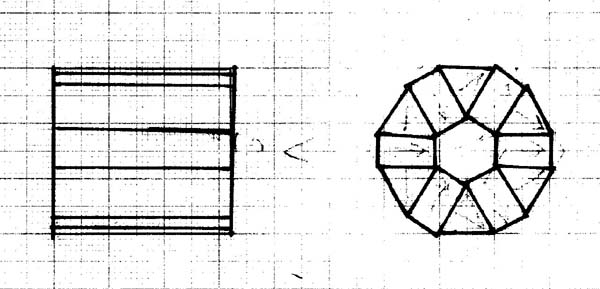
All up size, considering it would probably be best if the whole were encased in plastic, would be around 4cm (diameter) x 4cm (height). Anyone got
some design ideas for the coil?
[Edited on 9-9-2010 by aliced25]
|
|
|
aonomus
Hazard to Others
  
Posts: 361
Registered: 18-10-2009
Location: Toronto, Canada
Member Is Offline
Mood: Refluxing
|
|
Have you considered modelling the field in FEMM at all? This would be a little better than guessing for dimensions and orientations. Eats up CPU power
though... 
http://www.femm.info/wiki/HomePage
|
|
|
watson.fawkes
International Hazard
    
Posts: 2793
Registered: 16-8-2008
Member Is Offline
Mood: No Mood
|
|
Quote: Originally posted by aonomus  | Have you considered modelling the field in FEMM at all? This would be a little better than guessing for dimensions and orientations. Eats up CPU power
though...  |
On the other hand, eating
up CPU time is far preferable to eating up shop time and material cost going through multiple prototypes.
|
|
|
un0me2
aliced25 sock puppet
  
Posts: 205
Registered: 3-2-2010
Member Is Offline
Mood: No Mood
|
|
AMEN
How to model the Gauss of a 10mm Equilateral triangle prism? It is N40 Neodymium, as is the 1/4" square prism... By the way, thank you very much for
the program suggestion.
Can I import from GoogleSketchUp?
No, apparently - I have to work out how to draw it in the finite materials program
EDIT - sussed it out - from what the model is telling me there would be a solid 0.5-0.6T field right through the middle of the model.
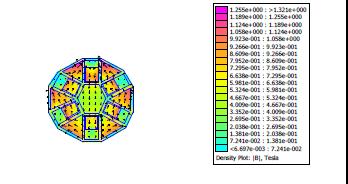
Actually, that is pretty fucking spectacular - my design gives about the same results as the one in the paper by Danielli, et al (above), using off
the shelf, cheap as fuck Neo magnets instead of specially machined/shaped Samarium Cobalt magnets and it is much smaller (while retaining the moving
parts so as to allow for "tuning" of the magnetic field).
Who says amateurs have to be "amateurish"?
Check out what happens when the two top triangular magnets are turned inward... An actual peak of 0.6T in the center, with an average through the
central area of ~0.58T
[Edited on 12-9-2010 by un0me2]
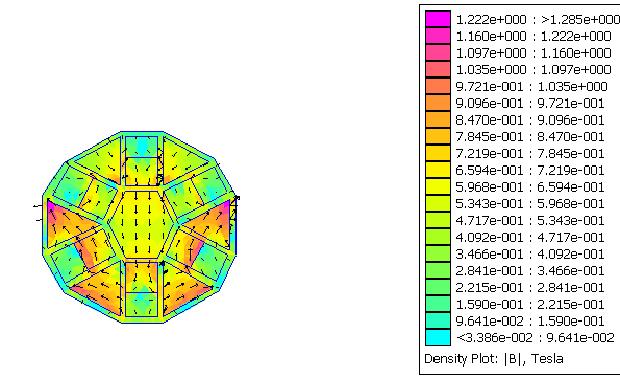
quam temere in nosmet legem sancimus iniquam
|
|
|
un0me2
aliced25 sock puppet
  
Posts: 205
Registered: 3-2-2010
Member Is Offline
Mood: No Mood
|
|
Amateurs may not be amateurish, but they can fuck up - when I went through the diagram of what I'd drawn I realised that despite setting the
preferences in mm it had retained them in inches, so the diagram attached to the previous post is innacurate.
The one attached to this is an accurate (or roughly so) rendition of what FEMM makes of the model. Note that the section graphed is through the
"middle of the model" where the coil would go and actually peaks in the center at just under 0.7T That pretty much matches what the pro's can do with much larger devices, this is approximately 4cm wide, by just over
3cm high, with a clear bore of about 6mm with a useable area in the center of about 2.5-3mm diameter (where the field is pretty well homogeneous
& appears to average 0.68-0.69T, in fact I'd be prepared to state that it is so, the defects on the model are more likely from my drawing than
from the "model" magnets). That pretty much matches what the pro's can do with much larger devices, this is approximately 4cm wide, by just over
3cm high, with a clear bore of about 6mm with a useable area in the center of about 2.5-3mm diameter (where the field is pretty well homogeneous
& appears to average 0.68-0.69T, in fact I'd be prepared to state that it is so, the defects on the model are more likely from my drawing than
from the "model" magnets).
It is rather higher nearer the poles so I may have to try out a couple of additional design ideas in order to increase it further. I also intend to
contact the local school and get them to see if they can measure the flux once I build the same. The central part is so cramped due to the design
incorporating aluminium framing (0.1", ie. 2.5mm - aluminium was one of the only choices offered, does anyone know enough about the plastics in this
area? How well they conduct magnetic fields, etc.?)
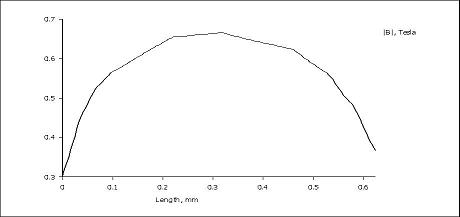 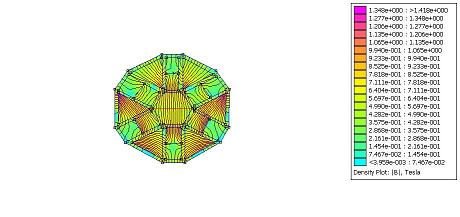
[Edited on 13-9-2010 by un0me2]
quam temere in nosmet legem sancimus iniquam
|
|
|
watson.fawkes
International Hazard
    
Posts: 2793
Registered: 16-8-2008
Member Is Offline
Mood: No Mood
|
|
Quote: Originally posted by un0me2  | Note that the section graphed is through the "middle of the model" where the coil would go and actually peaks in the center at just under 0.7T That pretty much matches what the pro's can do with much larger devices [...] the
field is pretty well homogeneous & appears to average 0.68-0.69T, in fact I'd be prepared to state that it is so, the defects on the model are
more likely from my drawing than from the "model" magnets). That pretty much matches what the pro's can do with much larger devices [...] the
field is pretty well homogeneous & appears to average 0.68-0.69T, in fact I'd be prepared to state that it is so, the defects on the model are
more likely from my drawing than from the "model" magnets). |
The real achievement of the pros is to get high
homogeneity of the field. You've got about 1% deviation now, 1 - 1E-2, but getting decently sharp peaks requires more orders of magnitude, say going
from 2 to 5.
|
|
|
12AX7
Post Harlot
    
Posts: 4803
Registered: 8-3-2005
Location: oscillating
Member Is Offline
Mood: informative
|
|
Plastics are unsuitable as they contain nuclei. Carbon obviously for one, and almost all contain hydrogen. Teflon might be suitable if you aren't
using fluorine resonance, but it suffers from cold flow, a non-starter for ppm accuracy over time.
Don't forget to note that aluminum is slightly diamagnetic. If you can turn up your calculator to ppm accuracy (heck, might as well calculate the
shim coils while you're at it, eh?), you must take this into account.
Tim
|
|
|
| Pages:
1
2
3
..
12 |